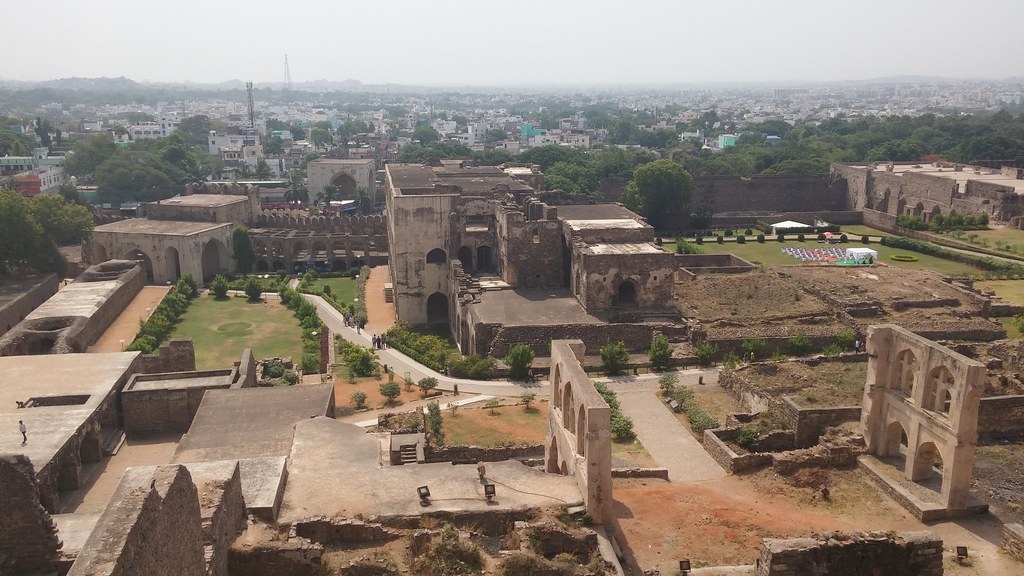If you happen to be in Hyderabad, a visit to the iconic Golconda Fort is mandatory. The fort, located in the city’s western part, is one of the most well-known attractions in Hyderabad. About 11 kilometres from the city centre,it is a beautifully preserved national monument.
The fort, which was built in the 16th century, is said to have once housed the magnificent Kohinoor diamond. It is said that if one claps his hands at the bottom of the fort, the echoes can be heard all the way up to the top of the structure.
The fortress’s classic architecture, rich history, and potential mysteries add to its allure and attract a large number of tourists from all over the world. The breathtaking opulence of Golconda Fort will leave you speechless in no time. The structure’s sturdy body, combined with the highly advanced architectural style, can leave any visitor awestruck and spellbound.
Tourists visiting the fort can also catch a glimpse of the breathtaking sunset view from the fortress’s highest point. Visitors can also take photographs of the fort’s unparalleled grandeur and take them home as beautiful souvenirs to remember their visit to the monument.
Another highlight of Golconda Fort is the incredible sound and light show that takes place here. This show, beautifully presented in front of the audience in three different languages, is sure to provide you with a truly unforgettable and magical experience. Make sure, you don’t miss visiting the fort if you are in Hyderabad.
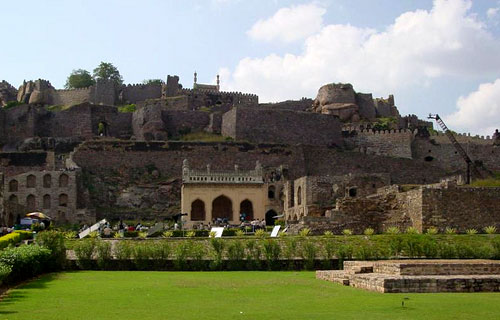
Post Contents
Golconda Fort History
The history of Golconda fort dates back to the early 13th century, when it was ruled by the Kakatiyas, who were followed by the Qutub Shahi kings, who ruled the region in the 16th and 17th centuries. The fortress is built on a 120-meter-high granite hill, surrounded by massive crenellated ramparts.
It was initially named as Shepherd’s Hill, which translates to Golla Konda in Telugu, and legend has it that a shepherd boy found an idol on this rocky hill and informed the governing Kakatiya king at the time. The king built a mud fort around this holy site, and Bahamani rulers took control of it after 200 years. Later, the Qutub Shahi kings expanded it into a gigantic granite fort with a circumference of 5 kilometers.
The fort remained a silent witness to historic events that took place over a period of time. The rule of Qutub Shahi at Golconda came to an end in 1687 when it was run over by Mughal emperor Aurangzeb, who left it in ruins.
Golconda Fort still has mounted cannons, four drawbridges, eight gateways, and grand halls, magazines, and stables, among other things. The outermost enclosure is known as Fateh Darwaza, which means Victory Gate, as Aurangzeb’s troops successfully marched through it.Golconda is home to a spectrum of mosques and palaces, many of which are unfortunately in ruins. The beauty and elegance of the fort is famous all over the globe.
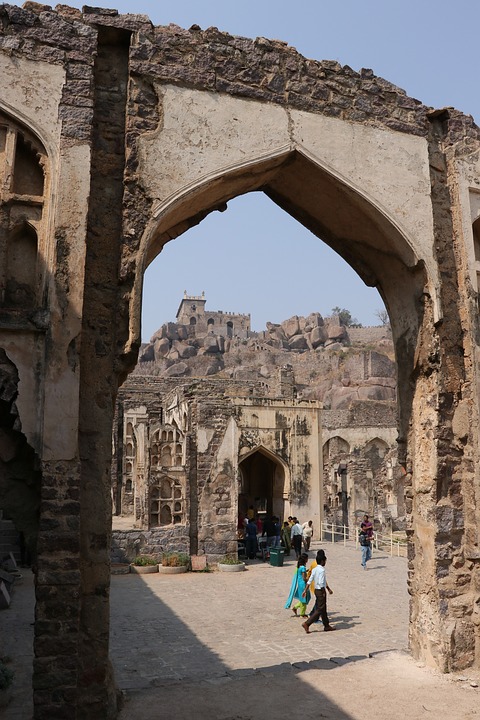
Related post: Gingee fort: 5 amazing facts that make it a must visit
Architecture of Golconda Fort
The architectural style of Golconda follows the Qutb Shahi architecture, a distinct style of Indo-Islamic architecture developed during the reign of the Qutb Shahi dynasty, also known as the Golconda Sultanate.
Qutb Shahi structures can be seen across Hyderabad and its vicinity. The Golconda Fort, which predates the city’s inception, is the earliest example of Qutb Shani architectural style. The style reached its zenith under the reign of Muhammad Quli Qutb Shah, who founded Hyderabad and built the Charminar as its centrepiece.
The Fort is designated as an archaeological treasure on the Archaeological Survey of India’s official “List of Monuments” issued under The Ancient Monuments and Archaeological Sites and Remains Act. Golconda is made up of four different forts, each with its own 10 km (6.2 mi) long outer wall, 87 semicircular bastions (some still armed with cannons), eight gateways, and four drawbridges, as well as a number of royal palace and halls, temples, mosques, stores, stables, and so on.
The lowest of them is the outermost enclosure, which is accessible through the “Fateh Darwaza” (Victory Gate, so named because Aurangzeb’s triumphant army marched in through this gate) in the south-eastern corner, which is studded with gigantic iron spikes (to prevent elephants from battering them down).
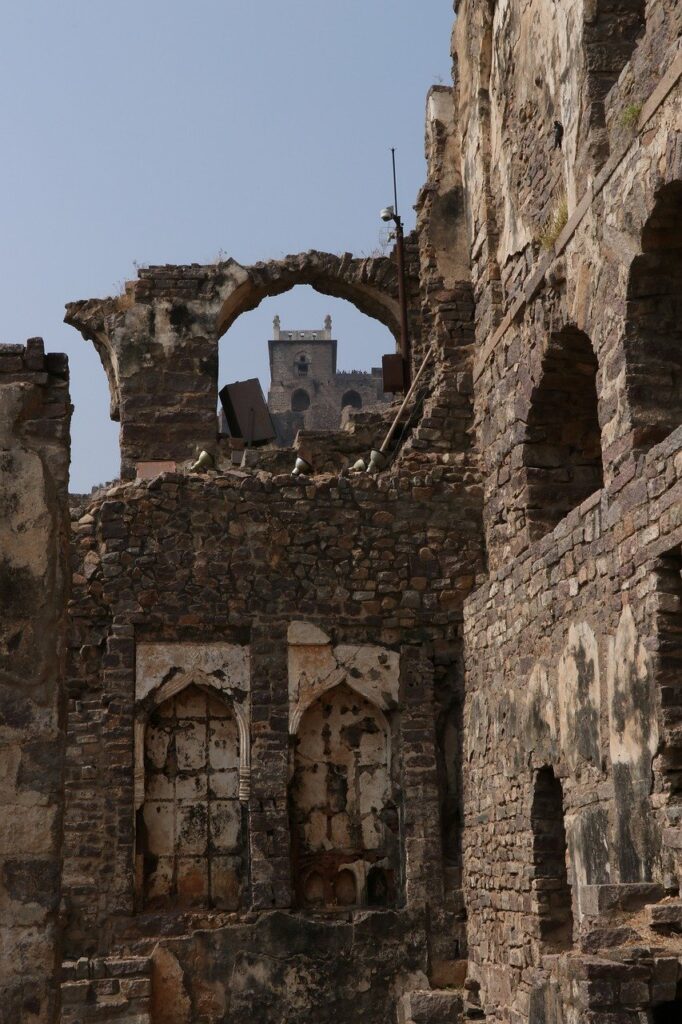
Bala Hissar Gate, located on the fort’s eastern side, is the main entrance. It has a pointed arch that is framed by rows of scroll work. The spandrels are embellished with yalis and ornamented roundels. Peacocks with ornate tails border an elegant arched niche over the door. A disc is flanked by sculpted yalis on the granite block lintel below. The use of peacocks and lions in the design is typical of Hindu architecture and contributes to the fort’s Hindu origins.
Toli Masjid, located in Karwan, about 2 kilometres from the Golconda Fort, was built in 1671 by Mir Musa Khan Mahaldar, Abdullah Qutb Shah’s royal architect. The facade is comprised of five arches, each with a lotus medallion in the spandrels.The main arch is wider and more elaborate. Inside, the mosque is divided into two halls: a transverse outer hall and an inner hall accessed via triple arches.
It is claimed that a secret tunnel leads from the “Durbar Hall” to one of the palaces at the foot of the hill. The tombs of the Qutub Shahi kings are also housed within the fort. These Islamic-style burials are located about 1 km north of Golconda’s outer wall. They are flanked by lovely gardens and many carved stones. It is also believed that there was also a secret tunnel to Charminar.
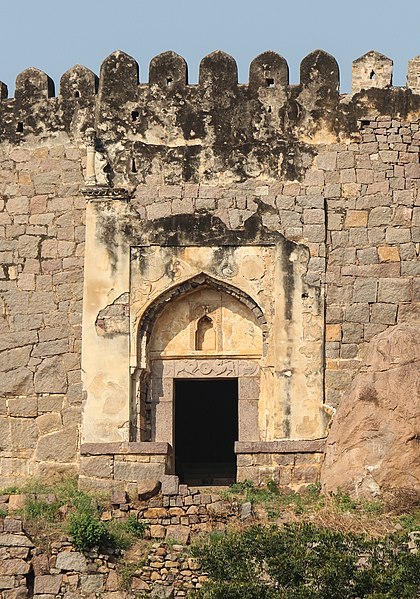
Do Read: Visiting the land of Ramana Maharshi and Arunachaleswar
Acoustic Wonder of Golconda Fort
One of the many reasons why visitors are drawn to the fort is its acoustic system. The sound of clapping at the entrance can be heard almost a kilometer away at the ‘Bala Hissar,’ the highest point.
It means that a single hand clap at any point below the dome can be heard at the highest point of the Golconda Fort. It could be used in the event of an attack on Golconda Fort. This system appeared to be used for communication purposes.
This was made possible due to a series of arches built in diminishing size on one side of the grand portico. The design and strategic construction of the arches helps to compress the sound waves created under the dome of the portico. It then bounces the sound waves back, amplified enough to reach a distance of up to a mile. –
These acoustics proved useful to the Qutb Shahis during Golconda’s reign as the capital of the Kingdom, up to 1591, a period during which the fort was attacked several times. But they could not help prevent the fall of the Kingdom and the ransacking of the fort in 1687, when the Mughal emperor Aurangzeb seized Golconda. Fortunately, the citadel was not razed by the Mughals. Large sections of it remain intact and the fort is one of the three landmarks of Hyderabad which reflect the glory of the Qutb Shahi Dynasty.
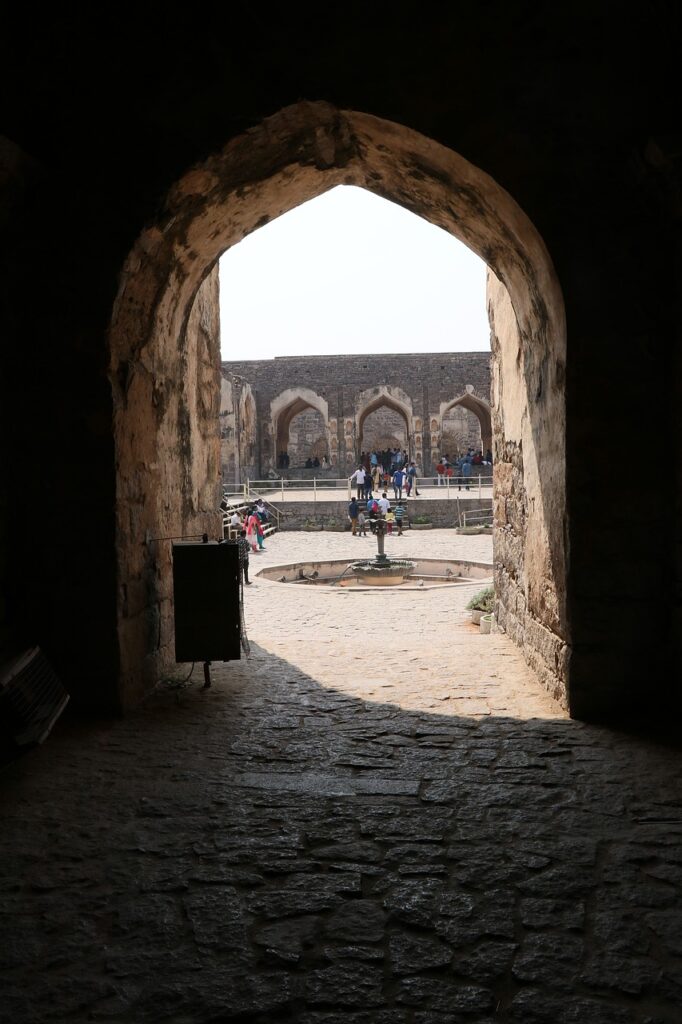
Light And Sound Show at Golconda fort
The sound and light show is one of Golconda Fort’s main attractions that takes place in the evening. The show is available in three languages: English, Hindi, and Telugu. The English version of the show is available throughout the week, while the Hindi version is available on Tuesdays, Thursdays, Saturdays, and Sundays. On Mondays, Wednesdays, and Fridays, local visitors can see the show in Telugu.
The sound and light show takes place in the lovely area surrounding and within Rani Mahal. The show is presented twice daily in two different languages, and the timing of each show may vary depending on the month in which you plan to attend.From November to February, the first show begins at 6.30 p.m., followed by the second at 7.45 p.m. From March through October, the first show starts at 7 p.m., and the second follows at 8.15 p.m.
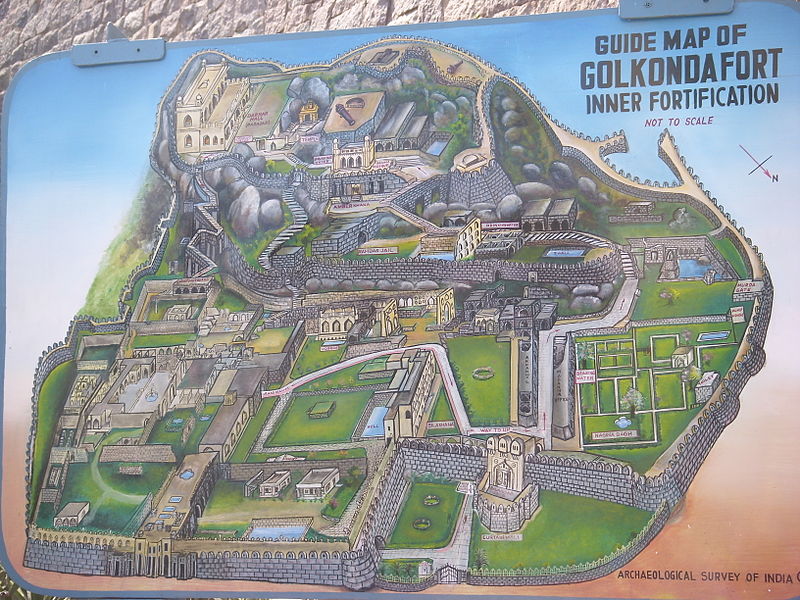
You may also like: Salarjung Museum in Hyderabad a must visit attraction
Travel Tips
1.Golconda Fort is around 11km west of Hyderabad’s city centre. While Rickshaws are readily available, taking the metro to either the Peddamma Temple Metro Station or the Jubilee Hills Check Post Metro Station is the simplest and quickest option (both on the Blue line).The metro stations are still a bit far from the Golconda fort, so you’ll have to take a Rickshaw the last leg of the journey, but you’ll avoid the worst traffic in Hyderabad.
2.During the warmer summer months, this part of India can be unbearably hot, especially for foreigners, with temperatures hovering around 40 degrees Celsius in the shade from April until the end of June. So the best time to visit Golconda fort is between September and March, when it is cooler.
3.Make sure you wear comfortable and breezy clothes and footwear as you would need to cover a lot of distance on foot. You will also have to do a bit of trekking to reach the citadel of the fort. Thus, you are also advised to carry sufficient drinking water and some snacks when heading to the fort.
4.A local guide may come handy who can explain the historical significance and uniqueness of the landmark monument. Tourists may consider hiring one.
5.Golconda Fort is public property and hence it is the responsibility of everyone to keep the place clean and tidy. So, avoid littering the premises of the fort.
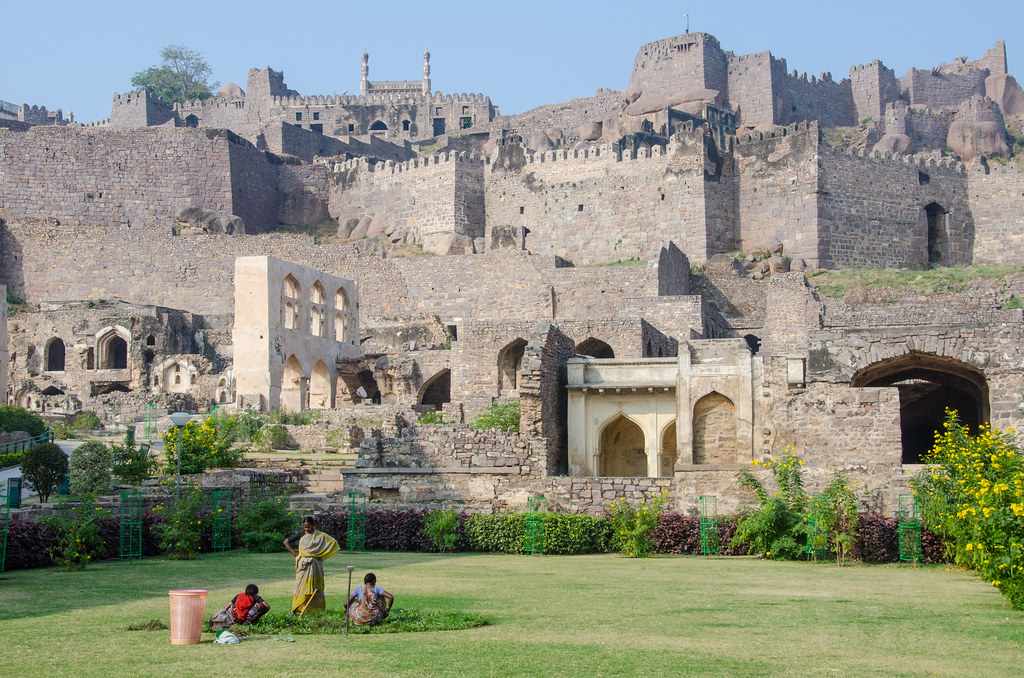
Do Read: Indira Gandhi Rashtriya Manav Sangrahalaya: Showcasing the real and indigenous India
Essential Information
Location: Khair Complex, Ibrahim Bagh, Hyderabad, Telangana 500008
Timings: Golconda Fort is open for visitors from 8 AM to 5.30 PM, throughout the week.
Entry fee: The price of the entry ticket to Golconda fort is INR 15 for Indian nationals and INR 200 for foreign nationals.
Visitor’s Facility: A plethora of decent and budget-friendly food joints are available near the fort where visitors to Golconda Fort can have a whole-hearted meal. In addition, there are also a host of good hotels at proximate distance to the fort where tourists can unwind and relax for the day.
Parking Facility: There is a dedicated, but small parking space at Golconda Fort.
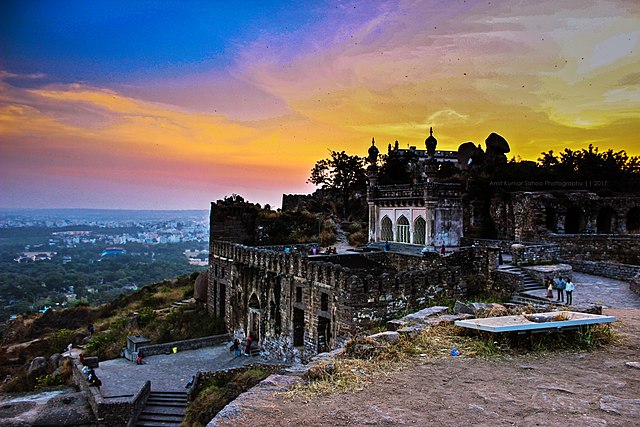
FAQ
Golconda Fort is well-known for a number of prominent features, varying from its inaccessible structure to its enthralling architecture. Other significant and thrilling features that have contributed to the fort’s fame in the country and beyond are the awe-inspiring sound and light show, the stunning sunset view from the fort’s highest point, and the mysteries surrounding the monument.
Tourists who visit Golconda Fort can engage in a wide range of activities. They can spend some time appreciating the fort’s elegance and beauty and architecture. They can also take decent shots of the monument, enjoy the alluring sunset view from the fortress’s highest point, and enjoy the sound and light show in the evening.
The Qutub Shahi rulers’ main capital was Golconda. The inner fort features remnants of palaces, mosques, and a hilltop pavilion that stands about 130 metres above the ground and provides a bird’s eye view of surrounding buildings. The Golconda fort complex is without a doubt one of India’s most beautiful fortification complexes.
Historically, the Golconda region was known for its diamonds, which were mined from the nearby hills’ conglomerate rocks, including the world-famous Koh-i-noor diamond and the fort once housed this iconic diamond piece.

